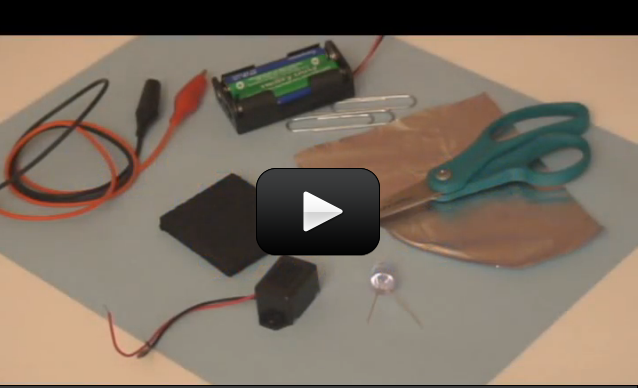By controlling how and when a circuit is triggered, you can easily turn a simple circuit into a burglar alarm – something that alerts you when something happens. By sensing light, movement, weight, liquids, even electric fields, you can trigger LEDs to light and buzzers to sound. Your room will never be the same.
Switches control the flow of electricity through a circuit. There are different kinds of switches. NC (normally closed) switches keep the current flowing until you engage the switch. The SPST and DPDT switches are NO (normally open) switches.
The pressure sensor we’re building is small, and it requires a fair amount of pressure to activate. Pressure is force (like weight) over a given area (like a footprint). If you weighed 200 pounds, and your footprint averaged 10” long and 2” wide, you’d exert about 5 psi (pounds per square inch) per foot.
However, if you walked around on stilts indeed of feet, and the ‘footprint’ of each stilt averaged 1” on each side, you’d now exert 100 psi per foot. Why such a difference?
The secret is in the area of the footprint. In our example, your foot is about 20 square inches, but the area of each stilt was only 1 square inch. Since you haven’t changed your weight, you’re still pushing down with 200 pounds, only in the second case, you’re pressing the same weight into a much smaller spot… and hence the pressure applied to the smaller area shoots up by a factor of 20.
So how do we use pressure in this experiment? When you squeeze the foam, the light bulb lights up! It’s ideal for under a doormat or carpet rug where lots of weight will trigger it.
Please login or register to read the rest of this content.


Yes, you can find more detailed information in this document here:
https://www.sciencelearningspace2.com/2015/06/radio-shack-component-replacements/
Does that help?
You say, “Radio Shack – see the shopping list for this unit and you can find the order links online.”
Do you provide SKUs somewhere or do you mean we just search “buzzer” (22 results) or “alligator clip wires”? Alligator wires yields 114 results, with different gauges of wire, single and paired wire, etc.
I’m guessing these are my best/most cost effective options:
BUZZER:
3VDC Mini Buzzer
Catalog #: 2730792 $3.99
The RadioShack 3VDC Mini Buzzer is used for a wide variety of applications, including audible alarms and distance measurement. This 75dB Piezo electric buzzer operates on 2-4VDC, carrying a maximum 50mA current with a tame buzzer tone rating of 300-500Hz.
ALLIGATOR WIRES: (either of these two?)
30″ (76.2cm) Test/Jumper Leads
Catalog #: 2780001 $9.49
A set of four color-coded alligator test leads. With an insulated clip at each end, these test leads provide secure connections for easier testing. One of each color—green, red, yellow and black.
2ft Color-Coded Jumper Leads (8-Pack)
Catalog #: 2781157 $7.49
A set of eight color-coded mini alligator test leads. With an insulated clip at each end, these jumper wires provide secure connections for easier testing. Two of each color—black, green , red and yellow.
My kids love the Idiot’s Guide to Magic Tricks as well as the Magic Book by Klutz. Enjoy!
how do you do magic tricks
Radio Shack – see the shopping list for this unit and you can find the order links online.
Where can you get a buzzer? We don’t have a hobby shop in Fredericton NB
Well, you can run a short (a wire) across the alarm to make the light on permanently, but I think you are asking how to latch it in the on position once it’s on, right? We’re actually shooting a latching circuit video now that will be added to this section very soon, so keep an eye out for it!
is there any way that i can make it so the light will stay on??
Cool – great ideas!! Thanks for sharing – and yes, the siren is a GREAT addition to this project (sorry, parents!)
What I did with my pressure plate burglar alarm was atach it to the front door. I built the project as directed but cut out a second piece of foam and placed a piece of plywood over the two pieces of foam ( one on each side of the plywood acting like feet keeping the plywood of the ground).
Then i hide the board and foam under a doormat and ran the wires under the door inside where my battery and siren where.
This works pretty good and 95% of the time some one walks in the door it sounds off.
This is more prectical if you use a 9 vott battery and a 9 vott rated siren ( it’s much louder)
Try this out
SETH VEENBAAS